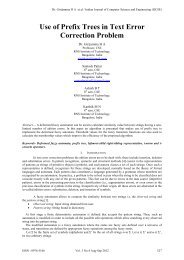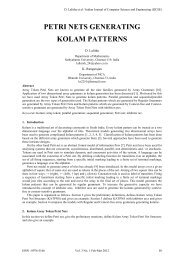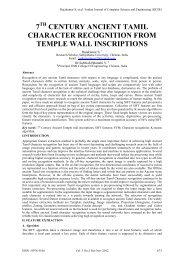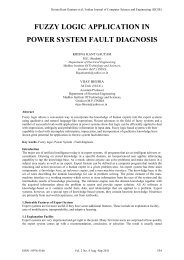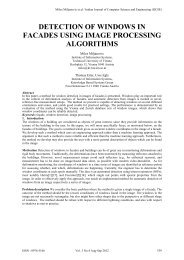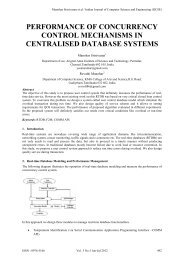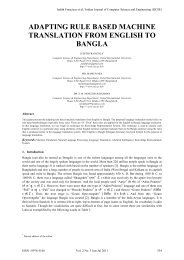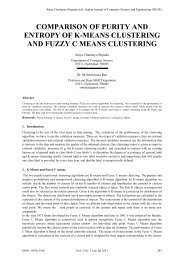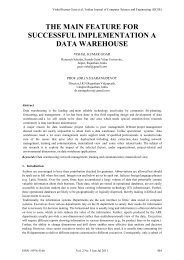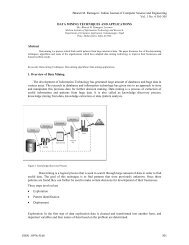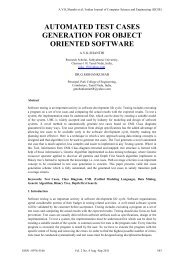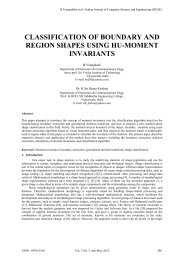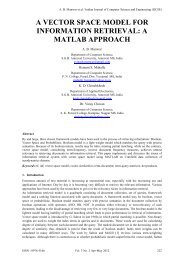Congestion in Wireless Sensor Networks and Mechanisms for ...
Congestion in Wireless Sensor Networks and Mechanisms for ...
Congestion in Wireless Sensor Networks and Mechanisms for ...
Create successful ePaper yourself
Turn your PDF publications into a flip-book with our unique Google optimized e-Paper software.
Raheleh Hashemzehi et.al / Indian Journal of Computer Science <strong>and</strong> Eng<strong>in</strong>eer<strong>in</strong>g (IJCSE)<br />
network per<strong>for</strong>mance through the protocols design, route algorithm choose, data <strong>in</strong>tegration <strong>and</strong> load balanc<strong>in</strong>g,<br />
<strong>and</strong> so on. [3].<br />
3. <strong>Congestion</strong> types <strong>in</strong> <strong>Wireless</strong> <strong>Sensor</strong> <strong>Networks</strong><br />
• Node-level congestion:<br />
The node-level congestion that is common <strong>in</strong> conventional networks. It is caused by buffer overflow <strong>in</strong> the node<br />
<strong>and</strong> can result <strong>in</strong> packet loss, <strong>and</strong> <strong>in</strong>creased queu<strong>in</strong>g delay[4].<br />
• L<strong>in</strong>k-level congestion:<br />
In a particular area, severe collisions could occur when multiple active sensor nodes with<strong>in</strong> range of one another<br />
attempt to transmit at the same time.. Packets that leave the buffer might fail to reach the next hop as a result of<br />
collision. This type of congestion decreases both l<strong>in</strong>k utilization <strong>and</strong> overall throughput, while <strong>in</strong>creas<strong>in</strong>g both<br />
packet delay <strong>and</strong> energy waste [5] [6].<br />
1- Node-level congestion 2 - L<strong>in</strong>k-level congestion<br />
Fig2: <strong>Congestion</strong> types <strong>in</strong> WSNS<br />
4. Overview Of <strong>Congestion</strong> Control Protocols In <strong>Wireless</strong> <strong>Sensor</strong> <strong>Networks</strong><br />
There have been several attempts to solve the problem of congestion control. In a review of related works <strong>in</strong> the<br />
context of wireless sensor networks congestion control is presented.<br />
<strong>Congestion</strong> Avoidance <strong>and</strong> Detection (CODA)<br />
CODA [7] is energy efficient congestion control mechanism designed <strong>for</strong> WSNs. CODA, detects the congestion<br />
by observ<strong>in</strong>g the buffer size of sensor nodes <strong>and</strong> the load of the wireless channel. If these two characteristic<br />
exceed from a pre-def<strong>in</strong>ed threshold, a sensor node <strong>in</strong><strong>for</strong>ms its neighbour to decrease the transmission rate.<br />
Be<strong>for</strong>e transmitt<strong>in</strong>g a packet, a sensor node divides the channel to fixed periods. If it found the channel busier<br />
than pre-def<strong>in</strong>ed times, it adjusts a control bit to <strong>in</strong><strong>for</strong>m the base station of the congestion.<br />
<strong>Congestion</strong> Control <strong>and</strong> Fairness (CCF)<br />
CCF [8]detects congestion based on packet service time at MAC layer <strong>and</strong> control congestion based on hop-byhop<br />
manner with simple fairness. CCF uses packets service time to deduce the available service rate <strong>and</strong> detect<br />
the congestion <strong>in</strong> each <strong>in</strong>termediate node. When the congestion is experienced, it <strong>in</strong><strong>for</strong>ms the downstream nodes<br />
to reduce their data transmission rate <strong>and</strong> vice versa.<br />
Adaptive Rate Control (ARC)<br />
ARC [9] monitors the <strong>in</strong>jection of packets <strong>in</strong>to the traffic stream as well as route-through traffic. Each node<br />
estimates the number of upstream nodes <strong>and</strong> the b<strong>and</strong>width is split proportionally between route-through <strong>and</strong><br />
locally generated traffic, with preference given to the <strong>for</strong>mer. The result<strong>in</strong>g b<strong>and</strong>width allocated to each node is<br />
thus approximately fair. Also, reduction <strong>in</strong> transmission rate of route-through traffic has a backpressure effect on<br />
upstream nodes, which <strong>in</strong> turn can reduce their transmission rates.<br />
SenTCP<br />
SenTCP [10] is an open-loop hop-by-hop congestion control protocol with two special features: 1) It jo<strong>in</strong>tly uses<br />
average local packet service time <strong>and</strong> average local packet <strong>in</strong>ter-arrival time <strong>in</strong> order to estimate current local<br />
congestion degree <strong>in</strong> each <strong>in</strong>termediate sensor node. The use of packet arrival time <strong>and</strong> service time not only<br />
precisely calculates congestion degree, but effectively helps to differentiate the reason of packet loss occurrence<br />
<strong>in</strong> wireless environments, s<strong>in</strong>ce arrival time ( or service time) may become small (or large) if congestion occurs.<br />
2) It uses hop-by-hop congestion control. In SenTCP, each <strong>in</strong>termediate sensor node will issues feedback signal<br />
backward <strong>and</strong> hop-by-hop. The feedback signal, which carries local congestion degree <strong>and</strong> the buffer occupancy<br />
ratio, is used <strong>for</strong> the neighbor<strong>in</strong>g sensor nodes to adjust their send<strong>in</strong>g rate <strong>in</strong> the transport layer. The use of hop-<br />
ISSN : 0976-5166 Vol. 4 No.3 Jun-Jul 2013 205



